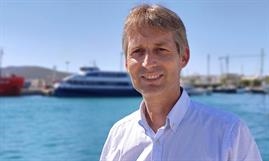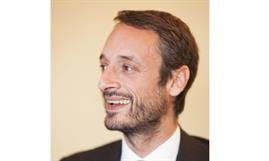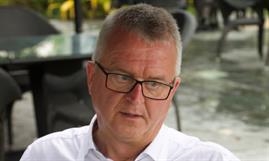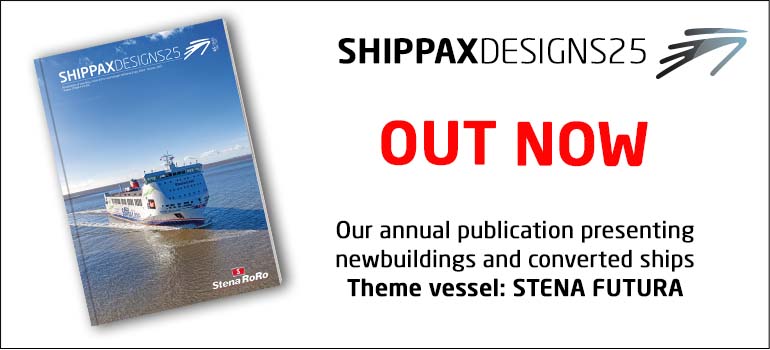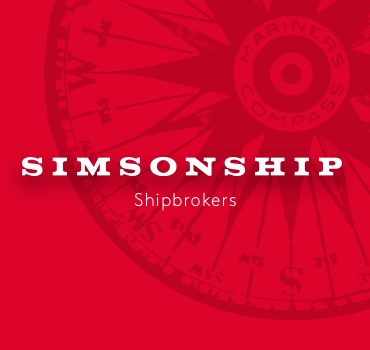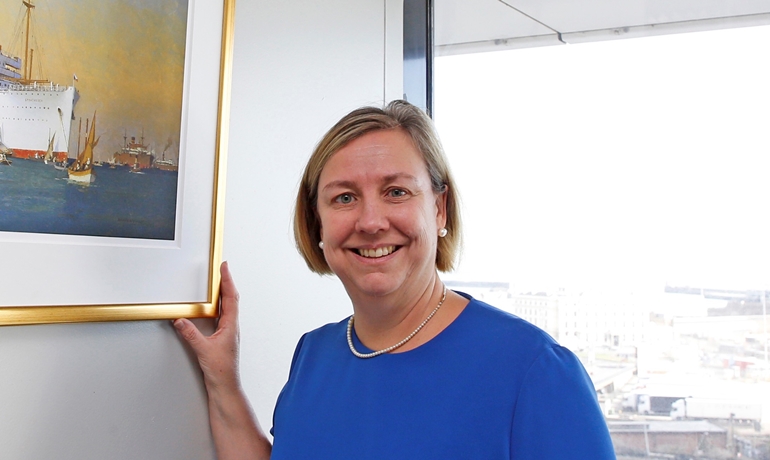
Janette Bell © P&O Ferries
P&O FERRIES TO TRANSFORM AND GROW ITS BUSINESS
InterviewThree months prior to the UK leaving the EU single market, Shippax’s editor met with P&O Ferries’ CEO to discuss her vision on the future of the UK’s most iconic ferry brand. Newbuilding plans for the Dover-Calais route were in an advanced stage but rather than assets, Janette Bell underlined that she puts customer focus first.
Janette Bell joined P&O Ferries in May 2012. Her journey to the top of the number one ro-ro freight carrier in the Calais-IJmuiden range was a rapid one, and she succeeded Helen Deeble as the company’s CEO on 1 January 2018. Brexit and the likelihood of a no-deal dominated the news at the time of this interview, but Mrs Bell didn’t want to speculate on the outcome of a hard or no-deal Brexit. “Politicians do what politicians do – I’m not a politician but rather a CEO of a ferry operation,” she smiled. So, what has been P&O Ferries’ Brexit strategy? “We don’t have a crystal ball,” she continued, “But as you would expect, we have been engaging closely with the authorities on both sides of the Channel and the North Sea and they have given us to understand that they are truly aware of the economic and commercial importance of the free flow of traffic across borders. The industry has come together to lobby on that. Equally, we expect that the governments and authorities will act to mitigate the impact of customs, sanitary control, border controls – you name it really – to ensure that our customers can continue to rely on our services.” Mrs Bell somehow saw Brexit and the consequences it might bring about as part of a wider picture. “Brexit is a here and now issue and you absolutely need to have your eye on that,” she explained, “But the ways of manufacturing goods and the distribution of goods, i.e. how goods will flow in the future, is actually at the heart of some of our future challenges.” This brought her seamlessly to the new vision on which P&O Ferries has embarked under her leadership.
TRANSFORMATION PROGRAMME
The Fourth Industrial Revolution is fundamentally changing the world. 4IR together with environmental challenges are actually at the core of the new vision and transformation programme P&O Ferries has developed. “We have taken a long moment to lift our heads up and look forwards and outwards,” Mrs Bell explained. “When one does that and looks at the changes that are happening both in the logistics space and the tourist space – the leisure market space – it’s pretty clear that there are some big changes. If you really start to think how those changes will come together, I absolutely believe that there will be big changes in the way that supply chains operate and, indeed, in the way that people engage with leisure businesses.”
As she pointed out, it’s not to just what the board thinks that counts in a business. “It’s about how you take your people on your journey,” she said. “More than 50% of our staff or about 2,000 people have directly engaged with the vision that I have laid out. They have been able to give their input to it and shape it. We have people in the business who really know what is going on and they are really excited about it. At the heart of what we are really trying to do is to drive a much greater customer focus into the business and we are actually in the process of reorganizing our customer centre business units.
“We have a lot of legacy infrastructure – whether that be systems, ports, ships – that we need to replace and refresh. We have challenged ourselves with what customers really want.”
There are big changes ahead in the logistics sector; autonomous vehicles and ships being some of them. “What we really need to think about is not only just the logistics, but actually the businesses that those logistics companies are serving, so the end-customer,” Mrs Bell went on. “When you start to look at manufacturing technology and see how that is advancing – take 3D printing, additive manufacturing and other things that are still in their infancy – and if you start to think about how that is combined with autonomous IT, Artificial Intelligence, then we can expect quite a shift in the way that goods are both manufactured and distributed. This will have an enormous impact on global supply chains and the regional supply chains in Northwest Europe. So, we have to start thinking about what part we will play – we are only a part player, but through P&O Ferrymasters and P&O Ferries, we can be quite a significant player. All these technological changes will not happen on the periphery of the industry but will come right into the heart of our businesses and we have to choose how to respond to them,” she elucidated.
“And it’s not just the freight or logistics market that is changing; the tourist and the leisure markets are transitioning from a service economy to an experience economy where business and organisations can create memorable events for their customers and where the memory becomes the product itself. P&O is an iconic brand in the leisure space – it is fantastic to have this as a starting point and to really think about what more P&O could be for the leisure customer. How can we create an event for our customers rather than the ferry being the product itself. So, it’s all about the experience on board and how you are creating these memories, i.e. how you take these memories beyond the actual crossing itself. That’s really what I’m challenging the teams of the marketeers in P&O Ferries to think about. One also has to consider the changes in demographics. People are getting older – what does that mean for travel? But, equally, what does ferry travel mean for a 15-year-old living his or her life on an iPad. How are we going to engage those people in the brand?”
In addition to the changes in the logistics and tourist spaces, there are also the environmental challenges that are addressed in P&O Ferries’ transformation programme. “We really want to see a lot more on the environment and this really needs to be coming up through the vision,” Mrs Bell told Shippax. “We have set up an environment taskforce. It’s not the typical people who you find in your fleet department. It’s rather people who have a passion for this and we have crafted a completely new environmental agenda for P&O Ferries. It’s amazing how there is that passion within the business – especially from the younger members in our team. When we talk about environment, we are not talking about the regulatory agenda. Of course, that’s part of it, but it’s about people who have the sea at their heart. It’s about marine plastics, renewable packaging, waste generated on board, paper boarding passes, etc.”
CUSTOMER-FOCUSED
On the North Sea, P&O Ferries serves three corridors – the Thames, the Humber and Teesport. The Humber (Hull) services from Europoort (Rotterdam) and Zeebrugge have a passenger element, but the ro-paxes – especially the 1987-built PRIDE OF BRUGES and PRIDE OF HULL – are not the newest ones in the market and therefore lack economies of scale. According to Mrs Bell, this is not too much of an issue. “It’s about understanding your customer,” she said. “It also depends what customers you are focusing on. Whilst it is great to have a massive 7,000-lanemetre ship and to have your real economies of scale on your cost per unit, if you cannot discharge it and get your traffic away for it to meet their end-customer destination time scales, then actually it doesn’t matter that you save so much of the cost per unit. What matters is to really understand who your customers are, what they are trying to achieve and then make sure that your ships, your offer, your ports, your schedule – your absolutely everything – meet those needs. Those operators with these behemoths might have some customers with some needs and we might have different customers with different needs. I don’t think you need to be the same, there are other ways to compete.”
To free-up vehicle deck space and meet customer demand, P&O Ferries added a three times weekly lo-lo service between Zeebrugge and Hull in May 2017. More recently the container ship WEGA was introduced between Zeebrugge and Teesport. “The success of the Zeebrugge-Hull lo-lo service is amazing – it keeps on growing,” Mrs Bell revealed. “Containers are brought from our Ferrymasters terminal in Oradea, Romania, onto the Zeebrugge hub where we operate them onto our chartered lo-lo ship, across to the Humber and onwards in distribution. It’s a seamless operation. We have upsized the ship (ELISABETH which has a capacity of 336 TEUs of 14 tonnes), i.e. we have changed its configuration.”
Whilst the charter of ELISABETH seems to be more permanent, the P&O Ferries supremo told us that the introduction of the WEGA on the Zeebrugge-Immingham route is something of a stopgap solution to overcome the imbalance in ro-ro capacity – the 1,625-lanemetre MISTRAL sails opposite the 2,863-lanemetre BORE SONG. “Teesport is the gateway into northern England and on to Scotland,” Mrs Bell said. “When DFDS discontinued the Rosyth-Zeebrugge route, we saw customers that were looking for a new gateway into Scotland. Clearly, the MISTRAL and BORE SONG didn’t quite work for them. To help our customers and to make sure that we can keep freight moving, we have introduced WEGA. Admittedly, this is not an optimal solution and we have an improved plan for 2019. Our historic strategy on the North Sea routes has been to charter tonnage and we are hopeful to introduce chartered ro-ro capacity with a higher intake soon. Once again, it’s all about customer focus. We are increasing our tonnage and we have added a second train service that connects our Teesport terminal directly with Mossend (Glasgow) in Scotland. In partnership with PD Ports, all of our customers benefit bravely from this increased connectivity. Our Zeebrugge-Teesport route has become an unrivalled service to and from northern Britain.”
EXPANSION AT TILBURY
One of P&O Ferries’ big projects is its partnership with Forth Ports for the development of the Tilbury 2 river berth. “Our ambition with Tilbury 2 is that it will be at the heart of our Zeebrugge intermodal hub concept,” Mrs Bell clarified. “But it is not only Zeebrugge – there are also other ports that we could develop. The Tilbury 2 facility will take up to 600,000 freight units per year with two berths. And we will be the exclusive ro-ro operator.” When asked if she considered a new service from Rotterdam or another Continental port to Tilbury, she declined to comment. “We will not use the lock anymore, so transit times will be shorter. Faster and more efficient turnarounds will also come from the new river berth, giving opportunities to develop all sorts of routes which is absolutely at the centre of our agenda,” she added.
NEW SHIPS FOR DOVER-CALAIS
The six-ship Dover-Calais route represents a significant proportion of P&O Ferries’ business and remains at the core of the brand. Mrs Bell admitted that there have been some challenges in the tourist market, but last year the market returned to some growth and the number of cars went up by 6% on the Dover-Calais route alone. P&O Ferries couldn’t beat its 2017 record freight carryings though and lost market share to Eurotunnel’s Le Shuttle Freight. Commenting on the decrease in trailer carryings on the Dover-Calais route, Mrs Bell said: “The tunnel increased capacity in 2018, but one also needs to remember that, regrettably, we didn’t have the PRIDE OF KENT which was out for seven months. With one of six ships out, we had insufficient capacity to be able to lift all the freight. We typically deploy four of the ships on a flat five roundtrips a day with two ships operating on half rotations around the peak, so we make sure that we have our capacity when the peak is. When you have one ship out, inevitably the capacity goes down. Since the PRIDE OF KENT came back into service on 10 July, we have seen progression and market share has gone up again.”
Four of the six ships operating on the Dover-Calais route were built in the early 1990s and already back in 2016 P&O Ferries announced that a further fleet renewal programme for its premier route was envisaged. Newbuilds have still not been ordered, so what’s today’s situation? “We are still on track,” Mrs Bell made clear. “We have a good specification on the drawing board and we are in dialogues with shipyards around the world. We will be making announcements very soon – probably during the first quarter.” Have any lessons been learned from the Spirit Class? “We did fully evaluate the Spirit Class. The amazing thing about these ships is their ability to hoover up freight. We have taken those key lessons into our newbuilds. But these ships were designed more than ten years ago. We have to look forward and part of the reason why we spent a lot of time looking at the future and how things are going to change, was to make sure that these next-generation ships will move the P&O story on and really to be fit for purpose for the next thirty years and beyond.”
The twin Spirit Class ro-paxes have a separate upper car deck. Thanks to its 3.3m free height, the car deck is also utilized to take van traffic, a fast-growing market – especially on the Dover-Calais route. The stand-alone car deck has been well-received by the motorists as it is an altogether much safer and conducive environment than the freight decks and Mrs Bell told us that all those points would be taken into consideration for the new design. She underlined that the vision with the new ships is to further grow the business, but no decision has yet been taken as to the number of ships that will be ordered. She thought it was also too soon to comment on the ship’s propulsion type.
NEW BUSINESS UNITS
As part of the new vision, P&O Ferries has grouped its diverse routes into three separate business units (BUs) that are headed by a managing director. Because of the short journey time they have in common, the Dover-Calais route has been brought together with the Cairnryan-Larne route. A second BU concerns the overnight routes that have a ‘hotel’ function: Hull-Rotterdam, Hull-Zeebrugge and Liverpool-Dublin. “The latter route doesn’t have a similar hotel function like we have on the North Sea, but from a business perspective – the challenge of how you optimize your vehicle decks and cabins – it’s similar to the Hull routes,” Mrs Bell pointed out. The third business unit bundles the dedicated freight services. “The three businesses might have different size and scale, but all have huge opportunity. They have specifically been created to ensure that we can put much greater focus on our customers. We will get much more speed and agility to be able to drive through the service that is required in those business.” In addition to the three newly-created BUs, P&O Ferrymasters operates as the fourth BU.
SHIP UPGRADES PAYING OFF
Notwithstanding their age, P&O Ferries has no immediate plans to replace the Hull-Zeebrugge ro-paxes. “Two years ago we invested GBP 8 million in PRIDE OF BRUGES and PRIDE OF YORK and there are opportunities to do more,” Mrs Bell explained. “We see that customers are wanting a more premium travel experience on the overnight routes. It’s not just about getting from A to B, it’s about the experience and we recently invested about GBP 0.5 million in upgrading all our Club cabins on PRIDE OF ROTTERDAM and PRIDE OF HULL. We have also increased the number of Club cabins as they were selling out over and over again. It’s simple things like double beds, flat screen TVs, complimentary mini bars, Clarence toiletries, etc. Yet, in just six months’ time, the investment already paid for itself as the Club cabins generated a GBP 620,000 increase in revenue. We are now going to do more of this. The overnight experience is about comfort and a good night’s sleep, it’s about leisurely dining rather than a quick meal. Our longer routes have become something of a hotel experience and that’s what we are going to be focusing on.”
CHALLENGES
Brexit will bring challenges, but also opportunities. A no-deal Brexit still seemed likely at the time of writing, but Mrs Bell didn’t want to speculate once again what effect a no-deal could have on the Dover traffic. “The reason that Dover-Calais has more freight flowing through it than all of the other UK ports together is that it works for customers,” she said. “I’m not quite certain how a 90-minute Dover-Calais ferry crossing can be substituted by a 14-hour North Sea crossing.” When Britain leaves the customs union, there is the opportunity of duty-free returning, although Mrs Bell didn’t see a reason to expand the onboard shops. “If you compare how customers shop today to how they shopped in 1979, it is quite different. There is a change of consumer trends. What people bought when duty-free was there, where they bought it from and how they bought – it is very different; and today we don’t need physical shops anymore.”
Another challenge is the 0.5% sulphur cap that will be mandatory on the Irish Sea as of 1 January 2020. P&O Ferries was one of the pioneers to test a scrubber on board one of its Channel ferries, albeit without much success, so it rather switched to 0.1% sulphur compliant fuel in the Channel/North Sea SECA in 2015. “To make scrubber business cases work, it always helps if you have ships that are of a younger generation,” Mrs Bell commented, hinting that the age and the design of P&O Ferries’ ro-paxes on the Irish Sea would not warrant a ‘scrubberisation’.
© Shippax / Philippe Holthof
mar 01 2019
Most read
Carnival Corporation full-year results
dec 21 2025
Not a Merry Christmas for CMAL and CalMac as two newbuilding ferries – GLEN ROSA and ISLE OF ISLAY - are further delayed
dec 22 2025


